|
Welcome to Space Radio - the world's
first radio station dedicated to space and space
exploration.

|

|

|

|
|
HOW
IT WORKS
Space Radio is a global on-demand radio
station. It's one of 9 radio channels that you
can access 24/7 when you join Planet Earth
Radio. (You'll see the other channels down the
left of the page) All the interviews and features
on Space Radio are accessible when you want them. On this
channel you'll hear
exclusive in-depth Space news and interviews
plus features with the leading
names in Space and Astronomy. Click on one of the links below
for your Free 14 Day Trial. Plus, click
on any of the green 'Listen to Free Preview'
buttons to hear exclusive extracts from Space
Radio now.

Join
Space Radio Now - and get exclusive access to
the latest in Space and Astronomy

|

|


3 minutes
|
|
|
Mars Rover Missions - The Final Countdown
As NASA's two Mars Rovers close in on the planet, the exploration team are
making final preparations for the nail biting final approach. The first Rover to
arrive will be 'Spirit' on 3 January, closely followed by 'Opportunity' on
January 24. There are also missions to Mars from Europe and Japan. The main task
for the Rovers will be to search for more evidence of life on the Red Planet.
Mars Exploration project manager Peter Theisinger has been revealing exactly
what happens in the final few minutes leading up to the landing.
|
|

|
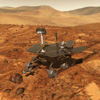

4 minutes
|
|
|
Mars Rovers equipped for remarkable scientific exploration
Once the NASA Rovers land, they will begin their exploration of Mars and
their search for evidence of life. Spirit and Opportunity are packed with
leading edge technology. They have 20/20 vision, the ability to drive around and
navigate the Red Planet, plus sophisticated equipment for analysing their
environment and reporting back to Earth.. Steve Squyres is the man responsible
for many of these instruments. He says the tension is growing as the moment to
test the technology comes closer.
|
|

|
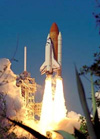

4 minutes |
|
|
NASA still on course for two shuttle missions in 2004 but warns of 'no
guarantees'
NASA's return-to-flight program is working towards two shuttle launches in
late 2004 but caution remains the watchword for the shuttle team. Two shuttles,
Atlantis and Discovery are being prepared for a flight window that begins
in September 2004. But there's still a long way to go. Atlantis is without
several major components that were removed for testing, while Discovery is being
re-assembled after major maintenance. Shuttle Program Manager Bill Parsons says
the overriding concern remains safety.
|



|
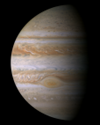

15 minutes
|
|
|
Stunning
Jupiter Photograph Revealed
- Carolyn Porco
The
world of Astronomy has been celebrating the
greatest Jupiter photograph ever seen. Taken by
the Cassini spacecraft en route to Saturn, the
photography captures Jupiter in unprecedented
detail. Listen now to our special interview with
Carolyn Porco, the Cassini imaging team leader, as
she tells the remarkable story of the Jupiter
picture and reveals why the photograph is causing
great excitement amongst Jupiter experts.
|
|

|


9 minutes
|
|
|
Approaching
Saturn – Cassini heads closer to historic
rendevous
After the success of its Jupiter by-pass, the
Cassini spacecraft is now focusing on its core
mission – the journey to Saturn. In part two of
our interview with Cassini team leader Carolyn
Porco at their HQ in Colorado, we get a sneak
preview of the content of the first Saturn images
coming in from Cassini. Carolyn also gives us a
detailed description of what lies ahead and how
this mission could unlock the key to some of
Saturn’s greatest mysteries.
|
|

|


22 minutes
|
|
|
Mars
Orbiter Camera team claim “smoking gun
evidence” of massive water flow on Mars
- Ken Edgett
The Mars Global Orbiter has come up with what looks like conclusive proof
of substantial rivers and waterflow on Mars,
possibly several billion years ago. It provides
clear, unequivocal evidence that some valleys on
Mars experienced the same type of on-going,
persistent water flow as rivers do on Earth. We
spoke to Ken Edgett at Malin Space Systems in San
Diego, whose team created and controls the Orbiter
camera. Ken gives us a detailed report on what
these amazing pictures reveal.
| Once you’ve clicked the ‘Play’ button on the left to hear the
interview, you can click
here to see the photographs in full
while Ken discusses them. |
|
|

Join Space Radio Now - and get exclusive access to
the latest in Space and Astronomy



|
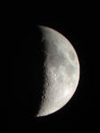

12 minutes
|
|
|
Special Report –
Water and Ice on The Moon, The Final Verdict?
Dr Bruce Campbell
The most
in-depth analysis ever carried out on the Moon’s
polar craters has not found any sign of the thick
deposits of ice which could have been used as
sources of water for future lunar visitors or
colonists. But the final verdict will probably only
come from a future manned or robotic mission.
Leading lunar authority Dr Bruce Campbell has been
telling us how he and his colleagues used the
powerful Aracebo Observatory in Puerto Rico to
explore 20 feet into the Moon’s soil – and he
tells us exactly what they found.
|
|

|


28 minutes
|
|
|
A Traveler's Guide to Mars
William Hartmann is one of the world's leading authorities on Mars. In this
special interview, he takes us on an amazing journey to the Red Planet,
revealing some of its secrets, the mysteries of its history and its potential
for future human visits. He tells you what you would see, hear and feel if you
were standing on Mars now. Plus William, who is author of the international
bestseller 'A Traveller's Guide To Mars' gives you his tops holiday tips for the
Mars vacation of a lifetime.
|
|

|


15 minutes
|
|
|
The Mars Olympics
In the second part of our interview with William Hartmann, senior scientist
at The Planetary Science Institute in Arizona, we get the lowdown on 'The Mars
Olympics' - the remarkable convergence of international missions to Mars which
are set to dominate the astronomy headlines over the next few months. Listen now
to discover why these missions are all heading to Mars at once, what they hope
to discover on arrival and the remarkable technology which allows the rovers to
explore the mysteries of the Red Planet.
|
|

|


9 minutes
|
|
|
Lunar experts ask for new Moon mission 'within a decade.'
The International Lunar Conference has ended with the world's leading lunar
experts calling for a new mission to the Moon within the next ten years. The
lunar luminaries met for a week in Hawaii to accelerate progress towards a
permanent human presence on the Moon. Although the Chinese delegation was
refused visas to attend the event, many believe that China's plans for lunar
missions may herald a new race for the moon. Conference organiser Steve Durst of
Space Age Publishing gives us this special report on the week's events in
Hawaii.
|
|

|


24 minutes
|
|
|
X
Prize Special Feature
X
Prize -
Is the Countdown Almost Over? Peter Diamandis
To
mark the launch of ‘Space Radio’ on the Planet
Earth Radio Network, we present a series of
interviews and profiles on the top names involved
in the X Prize – the $10 million global
competition to find the first private group who
can fly into space. In this special interview, X
Prize founder Peter Diamandis tells us how he came
up with his vision for the X Prize and how he’s
turned the vision into a competition that has
captured the imagination of space enthusiasts
across the world.
|
|

|


3 minutes
|
|
|
X
Prize Special Feature
SpaceShipOne Soars to Sixth Flight Test
Regarded by many as the favorite to win the X Prize, SpaceShipOne, the
creation of aviation legend Burt Rutan, has successfully carried out a sixth
successful test flight. A veil of secrecy has descended on the project's
headquarters at Scaled Composites in Mojave, California. Rutan is believed to be
funded by Microsoft co-founder Paul Allen. He certainly has more cash than his
fellow competitors - but does that guarantee success. We report on White Knight
and SpaceShipOne's race for victory.
|
|

|


11 minutes
|
|
|
X
Prize Special Feature
Canadian
Arrow prepares for launch with full astronaut
team
After a worldwide search for a team of
astronauts, Canadian Arrow has now selected the
team to lead its quest for X Prize victory. The
Canadian Arrow is a 54-ft long, two-stage, three
person sub-orbital rocket with the second stage
doubling as an escape system. The four
solid rockets can be ignited at any point during
the flight, including before launch, to initiate
a zero altitude launch pad abort or an in-flight
recovery sequence. Listen now as Canadian Arrow
team leader Geoff Sheerin gives us the latest on
his group's plans to claim this historic prize.
|
|

Join Space Radio Now - and get exclusive access to
the latest in Space and Astronomy



|
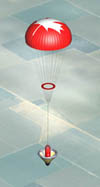

25 minutes
|
|
|
X
Prize Special Feature
DaVinci
Project use massive Helium Balloon to launch
their Space Quest
The da Vinci Project will launch its
spacecraft 'Wild Fire' from the world's largest
helium balloon. The rocket will be tethered
below the balloon and lifted over the course of
an hour to an altitude of 80,000 feet. The
10,000 pound thrust, liquid oxygen, kerosene
engines will fire the first stage and the rocket
will fly an initial angular trajectory to clear
the balloon. The rocket will reach a maximum
speed on both its ascent and re-entry of Mach 4,
or 2,650 mph. A flyable parachute will be
deployed at 25,000 feet and the rocket will
descend under control, guided by GPS, to a
predetermined landing zone. Team Leader Brian
Feeney tells us why DaVinci would be proud. |
|

|
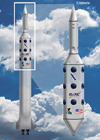

5 minutes
|
|
|
X
Prize Special Feature
Plan
for sea based launch enters X Prize race
High
Altitude Research Corporation is the latest
group to enter the X Pize. 'The Liberator'
is launched from sea and reaches an altitude of
approximately 70 miles. HARC President Gregory
Allison tells us why he believes that launching
from sea has many advantages such as longer
launch windows, lower range costs and smoother
FAA/AST licensing procedures. It also reduces
the risk to population centers to nearly zero.
|
|

|
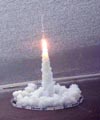

11 minutes
|
|
|
X
Prize Special Feature
Thunderbird
reaches for the X Prize Stars - Steve Bennett
Starchaser Industries in the
UK is aiming for X Prize victory with
‘Thunderbird.’ The vehicle will begin her
ascent in a vertical orientation using solid
boosters and liquid rocket engines. At higher
altitudes the main liquid oxygen/kerosene rocket
engine will take over, becoming the major
propulsive force in the now rarefied atmosphere.
Starchaser’s founder Steve Bennett gives us the
lowdown on Britain’s bid for the stars.
|
|

|


17 minutes
|
|
|
X
Prize Special Feature
Flying
high X-15 Style - David Ashford
Ascender is designed to be
the first sub-orbital aeroplane since the X-15.
Bristol Spaceplanes plan for Ascender to carry a
crew of two and two passengers to space and back.
Passengers will experience two minutes of
weightlessness, will see superb views of Earth,
and will see the sky turn black even in daytime.
It takes off from an ordinary airfield using its
turbofan engine and climbs at subsonic speed to a
height of 8 km. The biggest drawback is lack of
cash – but that’s not curbing the enthusiasm
of Ascender’s creator David Ashford.
|
|

|


14 minutes
|
|
|
Biocosm – Is this
the answer to the mysteries of the Universe
. James Gardner
A new theory
on the creation of the universe claims that the
universe was designed by a super-intelligent being
in a prior cosmic cycle – and that our descendents
will acquire similar powers. It may sound like an X
File too far, but the man responsible for the
theory, James Gardner is a respected complexity
theorist whose claims have received unexpected
praise from some members of the scientific
community. In this exclusive interview, he reveals
why the ‘Biocosm’ means the entire Universe is
actually a vast, emerging life.
|
|

|


14 minutes
|
|
|
Biocosm – Part Two
In the
second part of our interview with complexity
theorist James Gardner, he explains why the
super-intelligent being that created the universe
made humans so stupid, why Biocosm could explode the
Big Bang theory, why the entire universe is alive
and what the future has in store for us.
|
|
Marketing
Mix |






















